It is very important to select the correct PPE. Just as important,the PPE must be working correctly every time you use it, either alone or in combination with other PPE. Read the PPE user instructions carefully before every use, and seek assistance if needed.
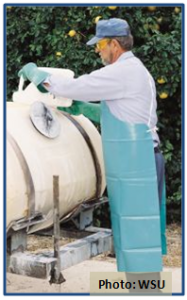 Aprons, when required, must be made of chemical-resistant material and cover the front of the body from mid-chest to the knees. It is a good idea to wear an apron whenever mixing or loading chemicals or cleaning spray equipment, even when not required on the pesticide label.
Aprons, when required, must be made of chemical-resistant material and cover the front of the body from mid-chest to the knees. It is a good idea to wear an apron whenever mixing or loading chemicals or cleaning spray equipment, even when not required on the pesticide label.
Coveralls are loose-fitting one- or two-piece garments that cover, at a minimum, the entire body except the head, neck, hands, and feet. The pesticide label may specify that the coveralls be worn over a layer of clothing. Most coveralls are made of fabric such as cotton or a cotton-polyester blend and are not chemical-resistant. There are laminated or coated materials that provide water resistance and protection from some solvents, but no US certification currently exists.
Eye protection requirements may be shielded safety glasses, goggles, a face shield, or a full-face respirator. Shielded safety glasses have a brow cover and side shields. Special goggles are needed when wearing a half-mask respirator or prescription glasses. Straps on eye protection equipment should be worn under any required protective headgear. There is an important difference between chemical goggles and ordinary safety goggles. Chemical goggles have a baffled airway that prevents a direct splash from getting inside the goggles. Ordinary safety goggles do not have this feature.
 |
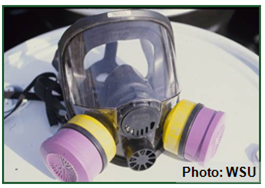 |
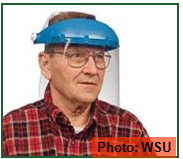 |
Footwear includes waterproof boots, or chemical-resistant boots or shoe coverings, worn over regular shoes or boots. Ensure that the footwear chosen will not absorb the spray. Always wear the pant legs outside the footwear to prevent spray from running down the leg into the footwear. Duct tape can be used to temporarily seal the area where boots meet the pants. Exposed footwear should be cleaned after each day’s use, and never worn indoors.
Glove(s) materials differ in their protective ability and the length of time they are protective after contact with the specific pesticide. The level of protection also varies depending on whether diluted sprays, concentrated product splashes, granules, or powders contact the gloves.
Pay careful attention to the glove types specified on the pesticide label. Some of the more common types of chemical-resistant gloves are made of nitrile, neoprene, and butyl rubber. Waterproof gloves are highly protective only for dry and water-based formulations. Pesticide labels will usually list “examples” of suitable glove types.
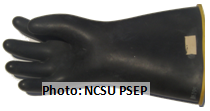 Butyl Rubber glove |
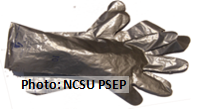 Barrier Laminate |
 Nitrile glove |
Always wear unlined gloves, and never wear canvas, leather, cotton, or other fabric gloves unless specified on the pesticide product label. Even highly chemical-resistant gloves must be rinsed off at breaks if pesticide contact occurs.
Wear sleeves outside the gloves if spraying below the shoulders. If spraying overhead, gloves should be outside the sleeves. If spraying both overhead and below the shoulders, duct tape can be used to temporarily seal the area where the gloves meet the sleeves. Elbow-length gloves are more protective and are required for some activities.
Headgear includes chemical-resistant hoods and chemical-resistant hats with a wide brim. Some labels require headgear – ensure that the headgear chosen will not absorb the spray.
Respirator requirements on pesticide labels are very specific when required for pesticide handling tasks. See the module on Respirators within this website for more detailed information. Use only respirators approved by the National Institute for Occupational Safety and Health (NIOSH). See the OSHA Respiratory Protection Regulation (29 CFR).
If you are required by the pesticide label to use a respirator an initial medical evaluation is also required by law.
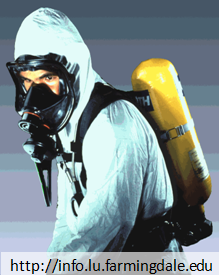 Self-contained, canister and cartridge style respirators require a tight seal to the face and must be fit tested before use. Fit testing is also required annually, or when the type of respirator changes, or when there are significant changes in weight or facial features.
Self-contained, canister and cartridge style respirators require a tight seal to the face and must be fit tested before use. Fit testing is also required annually, or when the type of respirator changes, or when there are significant changes in weight or facial features.
Only a trained person or safety professional should conduct the fit testing, according to the instructions included with the respirator or other fit test protocols specific to the model. Tight-sealing respirators cannot be worn by persons having facial hair (such as beards), jewelry, or other obstructions where the respirator contacts the face.
A respirator seal check (also known as a pressure check or fit check) is a very different procedure than a fit test. A seal check determines the effectiveness of the seal between the respirator and the skin and must be done EVERY time the respirator is worn. Follow the PPE instructions to conduct a proper seal check.
Replace filters, canisters, cartridges, etc. according to the pesticide label or PPE instructions (whichever is more frequent), and whenever there is equipment damage, breathing resistance, odor, taste, irritation, or soiling. Following the PPE instructions for replacement is critical, because other indicators are not always dependable. For example, the ability to detect an odor depends on the product, the person, and the weather conditions, and the mere presence of an odor does not indicate that harm can result.
Compiled by Wayne Buhler, PhD and David Jefferson MS
